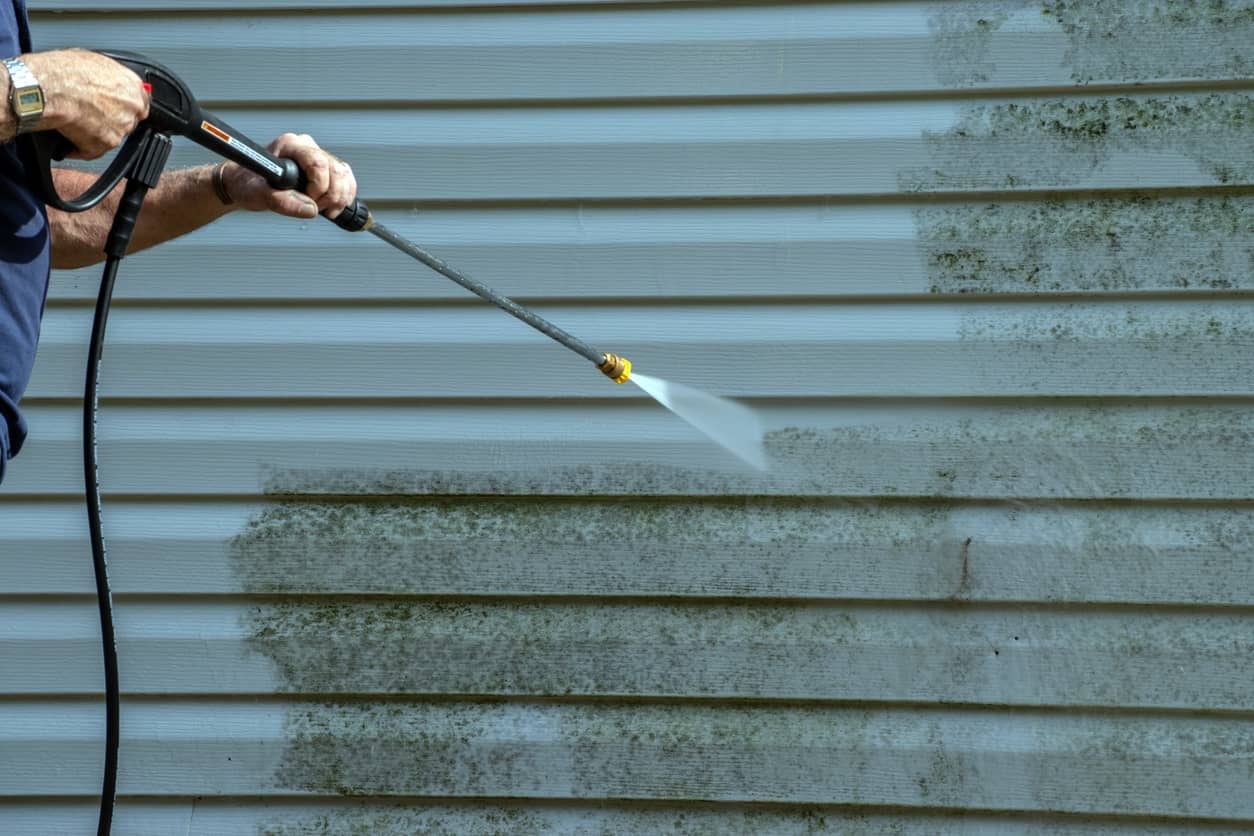That dark stain on your wood siding? It’s more than just ugly—it’s mold, and it’s eating into your home’s curb appeal. Mold on wood siding is a sneaky issue that can quickly spiral into something far more destructive than a visual nuisance. Left unchecked, mold can degrade the integrity of the wood, damage finishes, and even present health risks. But how can you remove it without ruining your siding?
The goal of this blog is simple—to provide clear, step-by-step guidance on how to safely and effectively remove mold from wood siding while preserving the natural grain. We’ll also cover when it’s best to call in a professional, because sometimes DIY cleaning just isn’t enough.
Understanding the Nature of Mold and Wood Siding
What Causes Mold to Grow on Wood Siding?
Mold thrives in damp, shaded environments. Factors such as poor ventilation, inadequate drainage, or prolonged exposure to humid weather all contribute to mold growth. Wood siding, especially in regions with frequent rainfall or humidity, can become a perfect breeding ground for mold.
Why is Wood Siding Especially Vulnerable?
Wood siding is particularly vulnerable because it’s porous. Moisture gets absorbed into the wood, which allows mold spores to embed below the surface. Once mold infiltrates the wood, it can be difficult to remove completely, and improper cleaning methods can worsen the damage. Aggressive scrubbing or using high-pressure washers can create deeper grooves, potentially causing the wood to swell, crack, or warp.
What Can Happen if Mold is Ignored?
Ignoring mold on wood siding can lead to:
-
Accelerated wood rot: Mold breaks down the cellulose in wood, weakening the structure.
-
Peeling paint or stain: Mold can affect the bonding between paint and wood, leading to premature peeling or chipping.
-
Health risks: Mold spores can affect indoor air quality, leading to allergies, respiratory issues, and other health problems.
-
Decreased home value: A moldy exterior detracts from your home’s curb appeal and can lower its market value.
Common Mistakes to Avoid When Cleaning Mold from Wood Siding
While cleaning mold off wood siding seems straightforward, there are several common mistakes that can lead to irreversible damage.
Using High-Pressure Washers Incorrectly
High-pressure washers can easily strip away the protective finish and etch the wood’s surface. The force of the water can also push moisture deep into the wood, which may cause long-term damage such as swelling, cracking, or warping.
Using Harsh Chemicals (e.g., Straight Bleach) Without Neutralizers
Bleach might kill mold on the surface, but it can strip away the wood’s protective sealants and alter its color or finish. It’s also toxic and can release fumes that are harmful to both the environment and your health.
Scrubbing Too Hard with Stiff Brushes
Using stiff brushes or wire brushes can scratch, scuff, or even fray the wood. These aggressive cleaning methods remove surface fibers, potentially damaging the natural grain.
Skipping the Rinse or Dry Phase
If you don’t rinse off cleaning solutions thoroughly, chemical residue can remain, creating streaks or compromising the wood’s ability to hold paint or stain. Similarly, failing to let the wood dry completely can encourage mold regrowth.
Not Testing Cleaners First
Not all cleaning products are safe for wood siding. Always test any cleaner on a small, inconspicuous area to make sure it doesn’t cause discoloration or damage to the surface.
Choosing the Right Mold Cleaner for Wood Siding
Safe and Effective Mold Removers for Wood
When selecting a mold remover, always opt for formulas designed specifically for wood siding. Here are some safe and effective options:
-
Oxygenated cleaners: Products like OxiClean or Sodium Percarbonate are gentle yet effective at breaking down mold without damaging wood.
-
Vinegar and water mix: A simple solution of white vinegar and water can help address light mold growth, especially if it’s caught early.
-
Commercial wood-safe mold removers: Products such as Wet & Forget Outdoor or RMR-86 Eco are designed to treat mold while being gentle on wood surfaces.
-
Borax solution: Borax penetrates deeply into wood, not only cleaning but also preventing future mold growth.
Features to Look for
-
Wood-safe, non-abrasive formulas: These protect the integrity of the grain and finish.
-
Biodegradable or low-VOC: Look for products that are eco-friendly and safe for the environment.
-
Mold inhibitor properties: Some products contain additives that prevent future mold growth, offering long-term protection.
What to Avoid
-
Full-strength bleach: Never use bleach on unsealed wood—it’s too harsh and can cause discoloration.
-
Ammonia or solvent-based cleaners: These can strip finishes and leave the wood vulnerable to further damage.
-
Products for non-porous surfaces: These are not meant for wood and can create more problems than they solve.
Step-by-Step Guide to Removing Mold from Wood Siding Without Damaging the Grain
Step 1: Inspect the Wood
Before starting, carefully examine the wood for mold, dirt, or mildew. Look for soft spots or areas that may have already begun to rot. These may need repair before cleaning. Take note of which areas are more shaded or retain moisture longer.
Step 2: Prepare Your Tools and Workspace
Gather all the necessary tools:
-
Soft-bristled brush: For gentle scrubbing without damaging the grain.
-
Garden sprayer or low-pressure hose: For applying the cleaner without too much force.
-
Buckets, gloves, goggles, mask: Protect yourself from exposure to mold spores.
-
Drop cloths: Lay down drop cloths to protect plants and soil from cleaner runoff.
Step 3: Pre-Rinse the Area
Use a garden hose—not a high-pressure washer—to pre-rinse the area. This will loosen dirt and debris and open up the pores of the wood, making the cleaner more effective.
Step 4: Apply a Wood-Safe Mold Cleaner
Follow the product’s instructions carefully. Spray the cleaner evenly from bottom to top to prevent streaks. Allow it to dwell for 10-20 minutes, depending on the product.
Step 5: Gently Scrub the Mold Away
Use a soft-bristled brush to scrub the mold away. Always work with the grain to avoid scarring or scratching the surface. Be careful not to oversaturate the wood, as excess water can damage the grain.
Step 6: Rinse Thoroughly
After scrubbing, rinse the area thoroughly using clean water, again from top to bottom. Make sure all residue is washed away to prevent any issues with mold regrowth or paint adhesion.
Step 7: Allow to Dry Completely
Allow the wood to dry for at least 24-48 hours. If you plan to stain or repaint, it’s important to check the moisture level using a moisture meter before proceeding.
How to Protect the Wood Grain During and After Cleaning
Don’t Oversaturate
Excess water can cause wood to swell, crack, or lift the grain. Always use as little water as necessary.
Always Go with the Grain
Scrubbing against the grain can cause scratches, while working with the grain helps preserve the natural texture of the wood.
Avoid Wire Brushes or Overly Coarse Sponges
These tools can damage the surface. Stick to soft-bristled brushes or non-abrasive sponges for the best results.
Use Sealants or Stains Post-Cleaning
Once the wood is completely dry, consider applying a wood-safe sealant or stain. This helps prevent future mold growth and keeps the grain intact.
When to Consider Calling a Professional
Situations Where a DIY Might Not Be Safe or Effective
If mold covers a large area or if the wood is particularly delicate (like cedar shakes), it’s best to leave the cleaning to professionals. Mold that keeps returning despite multiple cleanings could indicate underlying moisture problems that need to be addressed.
Professionals have access to specialized mold-removal equipment, such as gentle pressure washing and commercial-grade mold inhibitors. They also know how to properly seal and repaint the wood to ensure long-lasting results. They can assess moisture control issues like leaks, grading, or ventilation problems.
Not sure if your wood siding can handle another cleaning? Talk to your local paint or siding professional today!
Preventing Mold Regrowth on Wood Siding
- Improve Airflow: Trim back shrubs or trees that trap moisture near your siding. Ensure your attic or roofline has adequate ventilation to reduce humidity.
- Keep Siding Dry: Fix any leaky gutters or downspouts, and ensure the ground slopes away from the foundation to prevent water pooling near the wood.
- Seal and Stain Regularly: Use mold-resistant stains or paints for wood siding. Reapply every 2-5 years, depending on exposure to the elements.
- Consider Borate-Based Treatments: These treatments offer long-term protection against fungi and insects, providing peace of mind that your wood will stay healthy.
FAQs About Mold Removal on Wood Siding
Can I just paint over moldy wood siding?
No—painting over mold will trap the spores, which can cause bubbling or peeling paint.
Is vinegar strong enough to kill mold on siding?
For light mildew, yes. For more established mold, you’ll need a stronger product.
Will mold come back after I clean it?
It can if moisture issues aren’t fixed or the wood isn’t properly sealed afterward.
Is it safe to use a pressure washer on wood siding?
Only if set to low PSI (around 500–600) and using a wide spray nozzle. Too much pressure can damage the wood.
Clean Mold, Keep the Character of Your Wood Siding
Cleaning mold off wood siding is essential for maintaining both the appearance and health of your home. However, it requires a gentle, informed approach. By using the right products, safe techniques, and taking the time to let the wood dry properly, you can remove mold without harming the natural grain.
Remember, your wood siding is more than just an exterior feature; it’s a part of your home’s character. Treat it with care, and it will reward you with years of beauty. If in doubt, or if the project feels overwhelming, don’t hesitate to call in a professional to ensure your siding gets the attention it deserves.
🌿 “Your home’s wood siding has character. Keep it healthy and mold-free—without sanding it into dust.”





